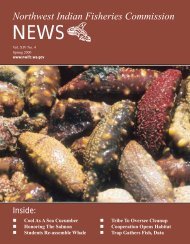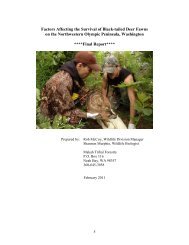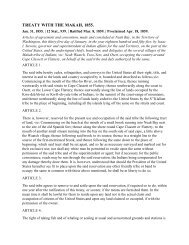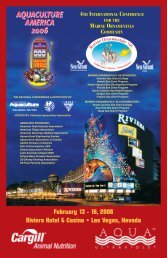NWIFC News - NWIFC Access - Northwest Indian Fisheries ...
NWIFC News - NWIFC Access - Northwest Indian Fisheries ...
NWIFC News - NWIFC Access - Northwest Indian Fisheries ...
Create successful ePaper yourself
Turn your PDF publications into a flip-book with our unique Google optimized e-Paper software.
New Hatchery Methods Aid Chinook<br />
The Puyallup Tribe of<br />
<strong>Indian</strong>s is using two cutting-edge<br />
techniques at its<br />
new Clarks Creek hatchery<br />
to boost fisheries on abundant<br />
hatchery chinook in<br />
the lower Puyallup River<br />
watershed while protecting<br />
a weak wild chinook run.<br />
Tribal and state co-managers<br />
have reduced fisheries<br />
on abundant hatchery<br />
chinook to protect the<br />
wild fish.<br />
“The tribe’s new hatchery<br />
at Clarks Creek will<br />
produce more chinook returning<br />
to the lower river,<br />
away from where returning<br />
wild chinook congregate<br />
in the upper watershed, so<br />
both tribal and non-tribal<br />
fishermen should have better<br />
chinook fisheries in the<br />
upcoming year,” said Chris<br />
Phinney, harvest management<br />
biologist for the Puyallup<br />
Tribe. Last year, the<br />
tribe had no directed fishery on chinook.<br />
As part of the tribe’s effort, a new automated<br />
coded wire tagging trailer will<br />
insert tiny metals tags into the snouts of<br />
the young fish, allowing biologists to better<br />
understand their life history.<br />
Also, an innovative type of rearing pond<br />
<br />
Desiree Wells, <strong>NWIFC</strong> technician, inspects juvenile chinook for fin clips<br />
before they are returned to a rearing pond at the Puyallup Tribe’s Clarks<br />
Creek hatchery. Photo: E. O’Connell<br />
Puget Sound chinook were listed under the federal Endangered<br />
Species Act in 1999. The same year, the Puyallup Tribe<br />
of <strong>Indian</strong>s released a list of restoration projects that would help<br />
save chinook on the Puyallup River.<br />
Eight years later, Puget Sound chinook are still in trouble<br />
and only three of the 13 projects suggested by the tribe have<br />
been completed. Five of the projects will never happen and<br />
another five are still on the shelf.<br />
“These project sites are valuable not only to salmon but also<br />
for houses,” said Russ Ladley, resource protection manager<br />
for the tribe.<br />
that mimics natural habitat conditions will<br />
better prepare the baby chinook for life<br />
outside the hatchery.<br />
In the trailer, the finger-long chinook are<br />
tagged, counted, and whisked back to a<br />
rearing pond. Codes on the millimeterlong<br />
tags indicate where and when the<br />
salmon were released.<br />
To mark the tagged<br />
hatchery fish, the small<br />
fleshy adipose fin on their<br />
back is clipped. When the<br />
tagged salmon are caught<br />
in fisheries or found on<br />
the spawning grounds, the<br />
tags are recovered and biologists<br />
track their survival<br />
rates, migration patterns<br />
and other information.<br />
Complementing the tagging<br />
program are the rearing<br />
ponds that re-create natural<br />
salmon habitat. Root wads,<br />
gravel and other materials<br />
are incorporated into the<br />
ponds to help the young chinook<br />
learn to survive better<br />
in the wild.<br />
“Chinook born in the<br />
wild develop instincts that<br />
help them avoid predators<br />
and find food,” said Smith.<br />
“Unfortunately, this isn’t<br />
something we see a lot of in<br />
hatchery fish raised in traditional<br />
cement ponds.”<br />
Chinook fisheries on the Puyallup River<br />
will likely be sharply limited again this<br />
year, but with more fish being produced<br />
each year at the Clarks Creek hatchery,<br />
future fisheries will likely improve. This<br />
spring, the tribe will release about 650,000<br />
chinook, and in a few years, nearly one<br />
million will be released. – E. O’Connell<br />
Habitat Projects Lost To Housing Developments<br />
Near Fife, a project was planned to reconnect 40 acres of<br />
off-channel habitat in the lower Puyallup River. Instead, the<br />
land became the site of hundreds of new houses.<br />
“The pressure to build houses is beating out the pressure to<br />
save salmon,” said Ladley.<br />
The tribe’s catalog of habitat improvement projects focused<br />
solely on off-channel habitat, a major need in the<br />
Puyallup River.<br />
Dikes along the mainstem of the river cut chinook off from<br />
their preferred off-channel hiding places such as wetlands and<br />
oxbow lakes.<br />
Completed projects include the reconnections of two wetlands<br />
to the mainstem, and a 1,000-yard levee dike setback.<br />
– E. O’Connell









